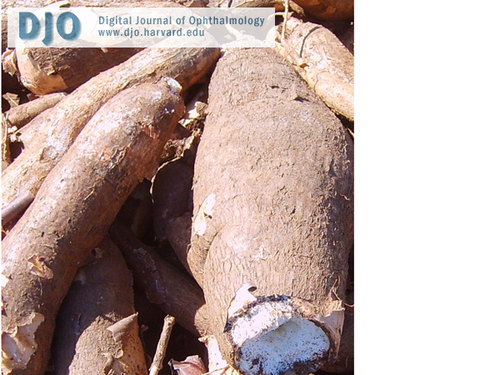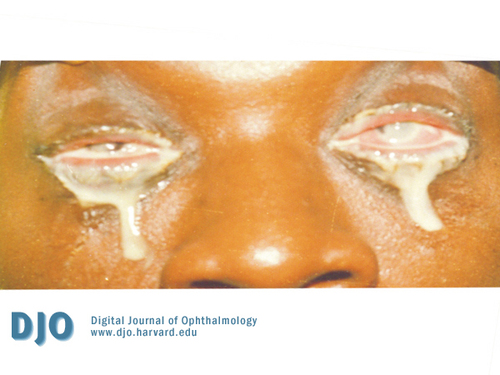A 39-year-old man with blindness following the application of raw cassava extract to the eyes
Digital Journal of Ophthalmology 2009
Volume 15, Number 2
May 30, 2009
Volume 15, Number 2
May 30, 2009
Download PDF

Figure 1
Cassava tubers
Cassava tubers

Figure 2
Photograph of the patient's eyes following the application of cassava extract. Note the lid edema, copious eye discharge, conjunctival erosions, corneas melting, and descemetoceles.
Photograph of the patient's eyes following the application of cassava extract. Note the lid edema, copious eye discharge, conjunctival erosions, corneas melting, and descemetoceles.
2. Bacterial conjunctivitis/keratitis was also suspected in this patient especially by virulent pathogenic organisms such as Neisseria, Haemophilus, Klebsiella, and Pseudomonas. The onset of ocular symptoms was short, and the progression was rapid. However, the negative culture, although not absolute, lowered this suspicion.
3. Adult chlamydial conjunctivitis should not be ruled-out totally in this patient especially since the patient is from agrarian community where he may have been exposed to poor hygiene and inadequate sanitation. Still, lack of history of sexually transmitted disease in this patient, and the copious nature of the eye discharge weakened this differential.
4. Fungal conjunctivitis/keratitis was also a possible diagnosis in this patient. However, the history was unusual for fungal eye infection. One would expect ocular trauma involving vegetative material as well as slower onset.
5. Viral conjunctivitis could be entertained in view of the short duration and bilaterality of the eye presentation. However, the patient was not exposed to contagious adenoviral conditions including epidemic keratoconjunctivitis and acute hemorrhagic conjunctivitis. Moreover, the discharge was not serous.
6. Orbital cellulitis could also be entertained in this patient. There was, however, no history of sinusitis, subperiosteal abscess, facial injury, or penetrating orbital injury that could lead to orbital cellulitis in this patient.
The deleterious effects of harmful traditional eye medications on vision have been widely reported.(4,5,6) The process leading to visual loss by traditional eye medications could be either by chemical burns to the ocular tissues, innoculation of harmful pathogenic organisms, or both.(7)
The patient in this report had failed self-medication using eye drops bought from a local chemist. The drug could have been steroid-based, worsening possible particulate foreign-body-induced corneal erosion especially in the right eye.
Both the patient and the priest were ignorant to the ocular condition, as their actions at least raised false hope and at most only provided psychological support. Most likely, the low level of education and low socio-economic class of the patient also contributed to his penchant for unorthodox treatment options. Perhaps, it could be argued that the lack of a readily accessible standard eye health care in the community was another compelling factor to the patient’s decision to seek unorthodox treatment.
In this patient, the treatment objective was to remove or dilute toxic cassava extract and purulent ocular discharge, to relieve pain, and to cover for pathogenic agents (bacteria and fungi). Other treatment plans were to provide psychological support, education of the patient and his relatives (who accompanied him to the hospital) on the danger of self medication and, of course, to rehabilitate the patient. Further management as well as ocular assessment could not be carried out as the patient was lost to follow-up after the fourth day.
The patient history, ocular examination findings, and negative culture results suggest chemical ocular injury. Raw cassava is not only acidic (pH 6.5) but also contains cyanide, among other constituents, that are potentially toxic to ocular tissue.(2,3) However, the speed of progression might have been accentuated by other insults, including particulate foreign bodies (which could have breached the corneal epithelium), pathogenic organisms, and unknown eye drops. The eye drops applied by the patient might have contained steroids, which would inevitably worsen the progression of any existing corneal erosion and infection. However, this could not explain the absence of an isolate in culture. On the other hand, an eye drop containing antibiotics is unlikely to worsen the progression of any existing corneal erosion and infection but could explain the absence of isolate on culture.
Raw cassava extract, based on its constituents, can cause chemical burns to the eyes with rapid destruction of ocular tissue leading to blindness. However, other added ocular insults may have served as catalysts to the cassava extract-induced ocular damage. Eye health education targeted toward agrarian communities on the danger of self eye medication including the use of traditional eye medications, especially raw cassava extract, will reduce avoidable blindness in the community.
2.Akindahunsi AA, Oboh G, Oshodi AA. Effect of Fermenting Cassava with Rhizopus Oryzae on the Chemical Composition of its Flour and Gari. Riv. Ital. Sostanze Grasse 1999;76:437-440.
3. Adewusi SRA, Ojumu TV, Falade OS. The effect of processing on total organic acids content and mineral availability of simulated cassava-vegetable diets. Plants foods for human nutrition 1999;53:367-380.
4. Ntim-Amponsah CT, Amoaku WMK, Ofosu-Amaah S. Alternate Eye Care Services in a Ghanaian District. Ghana Med J 2005;39(1):19–23.
5. Osahon AI. Consequencies of traditional eye medication in UBTH. Benin City. Nig J Ophthalmol 1995;3:39–41.
6. Sil AK. Primary prevention of red eye in the Indian context. Community Eye Health J 2005;18(53):s57-s58.
7. Yorston D. Measles and childhood blindness. Community Eye Health Journal 1991;8:2-4.